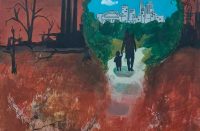Alternatives Journal is releasing our latest issue, Getting There: The Ecosystem of Human Movement.
The carbon footprint of an individual within a developed country is drastically higher than someone in a developing country. The reason behind this is partly in how we choose to get around. We drive to work every morning. We board cruises and airplanes to glamorous, far away destinations. We like to be always on the move.
Alternatives Journal is releasing our latest issue, Getting There: The Ecosystem of Human Movement.
The carbon footprint of an individual within a developed country is drastically higher than someone in a developing country. The reason behind this is partly in how we choose to get around. We drive to work every morning. We board cruises and airplanes to glamorous, far away destinations. We like to be always on the move.
The question becomes; how do we move from point A to point B and design the systems that help us to do so in a way that lowers our carbon footprint and leaves behind a positive lasting impact on the natural, social and economic environment? These questions will be answered in our latest issue, Getting There: The Ecosystem of Human Movement.
In this issue, we will discuss population growth and planning. As our population changes, we have become required to rethink city planning and discover the positive impacts of sustainable solutions such as greenways, bike lanes, improving city walkability, and retrofitting existing transportation infrastructure to better facilitate the movement of people and goods.
This issue will also explore the sustainability of traveling and the tourism industry. In the last few months, many airlines and cruise ships have had to park their fleets and seen a massive decline in customers. However, in the wake of a global pandemic that forced us to cancel our vacation plans, we were presented with the opportunity to reflect on how we travel and what tools we can use, like carbon offsetting, to help mitigate the impact we have.
Finally, this issue will critically assess our public transportation systems. How do we move away from a single car culture to a transit culture? What is the economic value of public transportation? How are other communities making their public transportation systems more sustainable? Asking these questions will have positive trickle-down effects to the entire community – whether that be through improving our physical and mental health, ability to access employment, or by protecting our natural spaces. This issue will answer these questions and hopefully prompt you to ask a few new ones.
This was an incredibly special issue. In the summer of 2020, four students from the Centre for Environment and Sustainability (CES) at Western University undertook this issue as co-op placements. There is an old Persian saying: “If you want to make God laugh, make a plan”. At A\J, we had lots of plans for how this summer was supposed to unfurl. We had a great team and a great work plan arranged in the early winter to start in May 2020. Of course, those plans were made oblivious to the deadly and tragic impacts of Covid-19 that were about to ensue.
Thankfully, the ‘sustainability’ focus of their education – with strong leadership from our issue’s guest editor, Professor Stephan Vachon (and the CES director) – allowed the team to dodge the flaming chainsaws of uncertainty and chase the golden unicorns of new opportunities. This issue is a testament to the power and capacity that emanates from campuses in London, Ontario and across the country, from coast to coast to coast.













